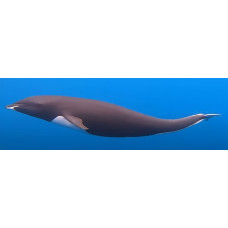Latin name
Lissodelphis borealis
Other names
Lissodelphis borealis
Identification
Have a slender hydrodynamic body. The fat pad on the head is low and the bill is narrow. The lower jaw is slightly protruding. The tail peduncle is thin. Teeth are thin and small (3 mm in diameter), 42-37 pairs in the upper jaw and 49 pairs in the lower jaw. There are 82 vertebrae in the spinal column. These dolphins make sounds without using whistles.
Features of fish fins
Fins are small, curved, narrow and pointed. The dorsal fin is absent. The pectoral fins are sickle-shaped.
Fish colouring
They are velvety black except for a white tip to the snout and a narrow, bright spot on the belly that begins on the underside of the caudal fin and ends in a diamond-shaped widening between the pectoral fins. Juveniles, which are initially born creamy dark gray or brown, acquire adult coloration by the age of one year.
Distribution
Occupies the North Pacific from the Bering Sea and Japan to California. In Russian waters it is found near the Kuril Islands.
Habitat
They inhabit the cold to temperate waters of the North Pacific Ocean with temperatures ranging from 8°C to 24°C (46°F to 75°F). They typically inhabit coastal, oceanic areas between latitudes 34°N and 55°N and 145°W and 118°E. However, during periods of unusually low water temperatures, they have been seen south of 29°N off the coast of Baja California, Mexico. Off the west coast of the United States, dolphins have been seen primarily on the shelf and in coastal waters.
Size
Body length up to 2.5 meters. Weight from 60 to 100 kilograms.
Behavior
They usually stay in small schools (3-10 individuals) and rarely approach the shore. They often jump out of the water high and frequently. They do not leave injured relatives and stay near them for a long time. They rarely follow ships. The migratory patterns of these dolphins are poorly understood. Their distribution seems to shift north in summer and south in winter.
These dolphins are fast swimmers. Their average swimming speed is about 16 mph (26 km/h), but they can reach speeds of 19-25 mph (30-40 km/h).
Food and feeding habits
They feed on cephalopods and fish. They can dive to depths of 200 meters (660 feet) in search of prey.
Reproduction
Data on growth and reproduction are limited. A study of net-captured dolphins allowed us to estimate mean age at sexual maturity, which was 9.9 and 10.1 years for males and 9.7 and 10.4 years for females. The mean length at sexual maturity was estimated to be 215.1 cm and 214.7 cm for males and 201.1 cm and 199.8 cm for females. The weight of mature testes ranged from 117.4 to 1300 g. The gestation period ranged from 12.1 to 12.3 months, with calving peaking in summer (July and August). The minimum labor interval was two years.
Fishing
These dolphins have long been a commercial species in Japan.
Relationship with a person
A few years ago, thousands of Lissodelphis borealis were dying annually in the waters of Japan, Korea and Taiwan as a result of bycatch. Today, the number of deaths has decreased.
| Classification | |
| Phylum | Chordata |
| Class | Mammalia |
| Squad | Artiodactyla |
| Family | Delphinidae |
| Genus | Lissodelphis |
| Species | L. borealis |
| Features | |
| Conservation status | Least Concern |
| Habitat | Pelagic |
| Life span, years | No information |
| Maximum body weight, kg | 100 |
| Maximum length, cm | 250 |
| Sailing speed, m/s | 11,11 |
| Threat to people | Edible |
| Way of eating | Predator |



